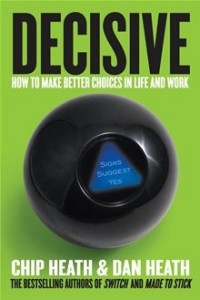 I’ve just finished reading Decisive: How to Make Better Choices in Life and Work
I’ve just finished reading Decisive: How to Make Better Choices in Life and Work, by Chip and Dan Heath, and planned to write an article recommending that you read it.
But I decided not to do that. Instead, I am going to let you make the decision totally on your own, using some of the techniques outlined in the book.
The Heaths tell us that bad decisions are all too common in business and personal decision making. 40% of senior level hires by companies don’t work out within 18 months, 83% of mergers don’t create value for shareholders, and personally we all make bad investment and relationship choices all the time.
While incomplete information is sometimes to blame, the process used for making the decision is about six times more important. To put it bluntly, our processes for deciding are usually wrong, and they cite four main villains: narrow framing, confirmation bias, short-term decision making, and overconfidence. Our brains are simply not optimally wired for making complex decisions. We can’t eliminate our biases, but we can plan for them and try to counteract them.
To counteract these villains, there are four steps we should apply that encompass a number of specific tactics to improve our outcomes. The steps are described in the acronym WRAP:
- Widen your options
- Reality-test your assumptions
- Attain distance before deciding
- Prepare to Be Wrong
Let’s apply some of their suggestions to the momentous decision: should you buy the book?
Widen your options. First, the question asked immediately above is the wrong one. Too often we turn decisions into either/or choices, which automatically shuts down the spotlight of our attention and closes out other options. The real choice is: how should I invest $14.97 and the time it will take to read the book? You could buy other books that might be more useful and/or more fun to read, or you could spend the money on a twelve-pack of Heineken and save the reading time. (Although I don’t recommend this technique just before making an important decision.) There’s no guarantee that any of the other choices will be better, but one study showed that “whether or not” decisions failed 52% of the time, compared to 32% for those where two or more alternatives were considered.
Reality-test your assumptions. When you consider whether to read a book, you might read some of the reviews on Amazon. If you’re leaning toward purchasing this book, you will note that there are 50 reviews, averaging 4-1/2 stars. There is only one 1-star review. Check it out, at least for a disconfirming opinion. I don’t agree with the reviewer (in fact, I note that he did not even finish the book), but some of his criticisms contain some truth.[1]
Another technique is to zoom out and then zoom in. Zoom out means to consider the base rate. I’m assuming if you’re considering a book on improving decision making that you hope it will improve your life in some way. In this case, I’m guessing the base rate (the percentage of people who read a book and actually make positive changes as a result) is probably quite low. But then, you zoom in and consider what factors might make you more successful than the base rate. The fact that you’re reading this suggests that you’re a person who is seriously interested in personal growth and self-improvement, so your chances of getting practical benefit from the book are probably quite good.
Attain Distance before Deciding. This suggestion goes against my own self-interest, because if you click on the link above to buy the book, I will earn about 28 cents. But, you really should not decide immediately. Put some time between the stimulus and the response and you can take the short-term emotion out of it. Another great technique is to consider whether you would recommend that your best friend buy this book if she were considering making a life-changing decision. Somehow we can think more objectively about others’ choices than about our own.
Prepare to Be Wrong. Despite following the first three steps, you can never guarantee that your decision will be the right one, so one technique you can use is taken from the world of investing. It’s called “bookending”. Rather than trying to predict what a stock’s price will be in the future, “bookend” a range from reasonable worst case to reasonable best case. Then, gauge where on that spectrum the current price lies. Closer to the left means high upside and closer to the right means high downside. For this decision, I can’t see a reasonable scenario where applying these techniques will worsen the quality of your decisions, so the downside is that you spend $15, and either don’t like or don’t apply it. The upside is that you keep your company from making a multi-billion-dollar mistake and become a hero.
Of course, some of your life’s decisions are much more important than the trivial example I’ve cited here, and that’s when a sound process for making decisions can make a real difference. There’s a lot I’ve left out, but hopefully you have enough of a flavor of the techniques in the book to make the right decision. Of course, the Catch-22 is that if you’re good at making decisions, you don’t need this book!


